Power BI Desktop visuals
Purpose of PowerBI Desktop application is to create reports on a local machine and publish them in the cloud for users who can see them anytime, at any moment, by Internet browser on a PC or a mobile device. Managers need to get clear, simple and visually nice reports. It seems that PowerBI meets all given criteria. In a text that follows I will describe various ways to create reports in PowerBI Desktop.
After we import the data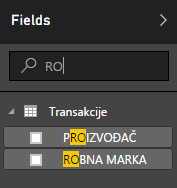 reporting dimensions will be displayed at the menu on the right side named Fields. On top of this menu is a search control. If there are too many dimensions (more that can fit on the screen) you can use this control to enter a criteria and list of dimensions will be filtered. On the left
reporting dimensions will be displayed at the menu on the right side named Fields. On top of this menu is a search control. If there are too many dimensions (more that can fit on the screen) you can use this control to enter a criteria and list of dimensions will be filtered. On the left 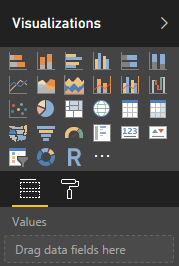 is the list of objects that we can use to create reports, and it is called Visualizations. These objects are also known as „Visuals“ and can be various charts (Bar, Column, Line, Area, Waterfall, Scatter, Pie, Donut, Map, Map Filled, Treemap, Funnel, Gauge, etc.), tables, cards, interactive filters- slicers… These are the default object to visualize data, but there are many others created by rich development community that you can download from the Internet. Usually we’re talking about some specific charts. Once you download them, you will add them to PowerBI Desktop by clicking on the icon “…” and then selecting the object (visual) that needs to be imported.
is the list of objects that we can use to create reports, and it is called Visualizations. These objects are also known as „Visuals“ and can be various charts (Bar, Column, Line, Area, Waterfall, Scatter, Pie, Donut, Map, Map Filled, Treemap, Funnel, Gauge, etc.), tables, cards, interactive filters- slicers… These are the default object to visualize data, but there are many others created by rich development community that you can download from the Internet. Usually we’re talking about some specific charts. Once you download them, you will add them to PowerBI Desktop by clicking on the icon “…” and then selecting the object (visual) that needs to be imported.
To create a report should choose some reporting dimension from Fields menu and drag in into Values box, just below collection of visuals. Default visual is a table. After we add a table, by clicking on another one we transform it to chart, card or a slicer. Descriptive fields are shown as labels, and aggregated fields as numerical values. Latter have same function as Values in Pivot tables, they are essential for displaying of data in chart.
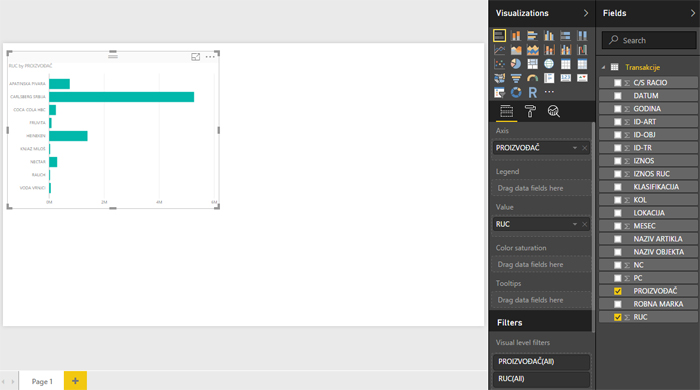
For example, if you add PROIZVOĐAČ and RUC you’ll get a table. If you further click on Stacked Bar Chart it will transform into a chart.

If necessary you can get a table and a chart that share same data source. It is accomplished by creating a table, copying+pasting it into report, and then modifying one of them to chart. These objects are interconnected, so when you click on a bar within a chart you will both filter chart and the table.
Right below visualization options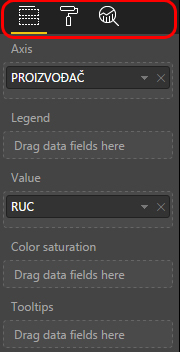 there is a menu with several icons. First is used to display values by which chart is displayed (Values). Depending on the type of the chart additional fields will be shown to give additional meaning to the report. Second option, shown as paint roller, contains numerous formatting options. For example, if visual is a table you’ll be able to choose options for changing font, size, style, color… If it is a chart you’ll be able to change colors of certain chart elements. Last icon within this menu, resembling a magnifying glass, contains options for adding more lines in a chart as: minimum, maximum, average etc.
there is a menu with several icons. First is used to display values by which chart is displayed (Values). Depending on the type of the chart additional fields will be shown to give additional meaning to the report. Second option, shown as paint roller, contains numerous formatting options. For example, if visual is a table you’ll be able to choose options for changing font, size, style, color… If it is a chart you’ll be able to change colors of certain chart elements. Last icon within this menu, resembling a magnifying glass, contains options for adding more lines in a chart as: minimum, maximum, average etc.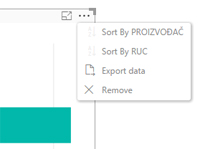 In upper right corner of each chart is a menu. Its first icon enables focusing (zooming) of a chart. When chart is zoomed by clicking Back to report label, shown in upper left corner, you’ll get back to the chart. By clicking „…“ icon some additional options will show, as sorting or removing an object (table, chart, card, slicer).
In upper right corner of each chart is a menu. Its first icon enables focusing (zooming) of a chart. When chart is zoomed by clicking Back to report label, shown in upper left corner, you’ll get back to the chart. By clicking „…“ icon some additional options will show, as sorting or removing an object (table, chart, card, slicer).
At the end, reports are grouped by pages. They have similar functionality as worksheets within Excel document. You can find them similarly at the end of a window, and there are also options for adding, deleting, renaming report pages.
